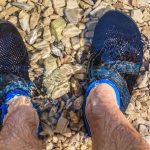If we look at the similarities between trail and road running shoes, there are a lot of similarities.
Take, for example, the Brooks Ghost 14; it is a good shoe because you can wear it for anything. It will fit nicely for fast runs, slow runs, unpaved gravel roads, packed trails, or even marathons.
Sure, the Ghost doesn’t excel in one specific area but when it comes to running shoes, this is as good as it gets.
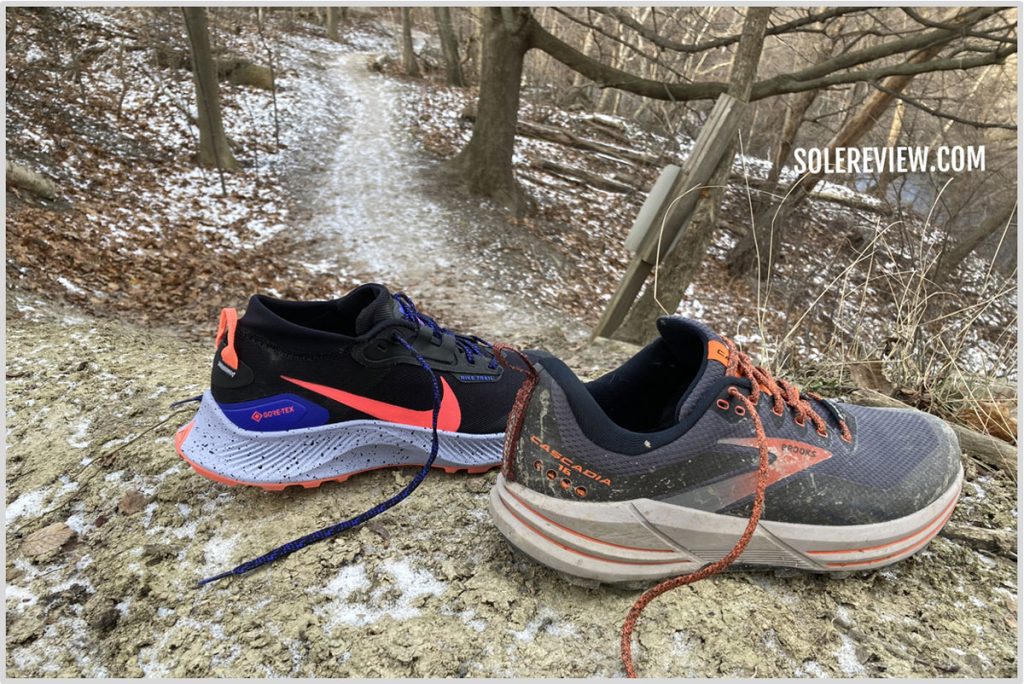
Likewise, there are many trail shoes with do-it-all versatility. Uppers of both categories require a secure fit, however the upper of a trail shoe is typically made out of tougher materials for protection purposes and will not stretch or flex like other shoes.
‘Technical’ footwear designates shoes specifically made for racing; these could include low-profile racing flats or hybrids such as the Adidas Boston 10. Uppers fit narrow to provide superior stability at high speeds, and so shoe laces need not be tightened for lockdown purposes.
There are parallels in the trail running shoe world as well. Although technical running can be fast paced, it is less about how fast one can go and more about making that run an engaging experience.
There are many ways to describe the term clear sky depending on what type of ground you’re standing on or how it’s currently raining.
All technical trails present a high degree of difficulty because they consist of uneven surfaces made up of rocks and roots which may also include factors such as dust or mud, ice, snow, and occasional water crossings.
Technical trails are commonly found to have uphill and downhill portions; they each require different running shoes. Downhill, your speed is much faster than it would be uphill. You are looking for good footing while always watching out for obstacles like roots and loose stones. This is an action that requires a high velocity, thus requiring you to change footfalls frequently so that there will be less impact if you lose balance.
Unlike the straight-forwardness of roads or flat gravel paths, running along technical terrain is much more difficult. Landing where you want to is unpredictable; it requires agility and intelligence. For this reason, we prefer shoes that promote proprioception over those without it.
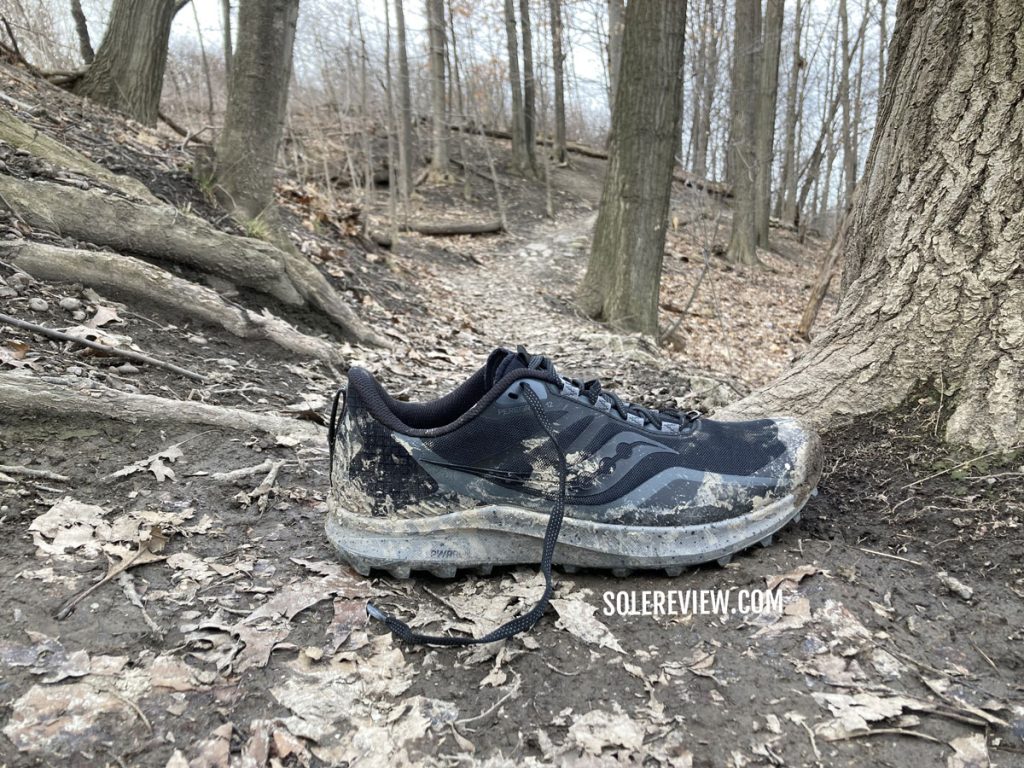
Technical Trail runners can use a variety of foot-strike patterns that are all dependent on the situation. They could be Forefoot, Midfoot, or Heel Landing based up what they’re doing but no matter what they’re always making a lot of Side-to-Side movements. Climbing steep verticals is always a challenge for them too because there’s always something new to think about when you’re going up hill.
In other words, where you’re going to run will determine which trail shoe you should choose.
Your trail runs are limited to running on gravel paths in the neighborhood park? If so, you don’t need a purpose-built trail shoe. Your regular road-running shoes work just fine for that.
If you’re seeking a more outdoorsy feel, go for one of those soft-roaders. These are like outdoor versions of the road shoe with an outer sole made up of durable rubber and an upper made from sturdy mesh.
They’re like the shoe equivalent of a compact SUV or crossover vehicle. Nike Pegasus Trail 3 and Asics Kayano 28 AWL (we’ve included them in our list) are good examples.
Versatile trail running shoes like the Altra Lone Peak 6, Brooks Cascadia 16, and the Saucony Peregrine 12 can be used for every type of terrain from low difficulty level to high difficulty levels. These shoes provide decent protection for both the upper part of your foot and the bottom half which cushions you against unwanted blows or jolts.
Technical trails present you with a lot of decisions to make about shoes. Thin soles mean feeling the ground beneath your feet for an even better sense of weight and power transfer but also means more often getting jabbed in places such as underfoots by rocky edges or sharp roots.
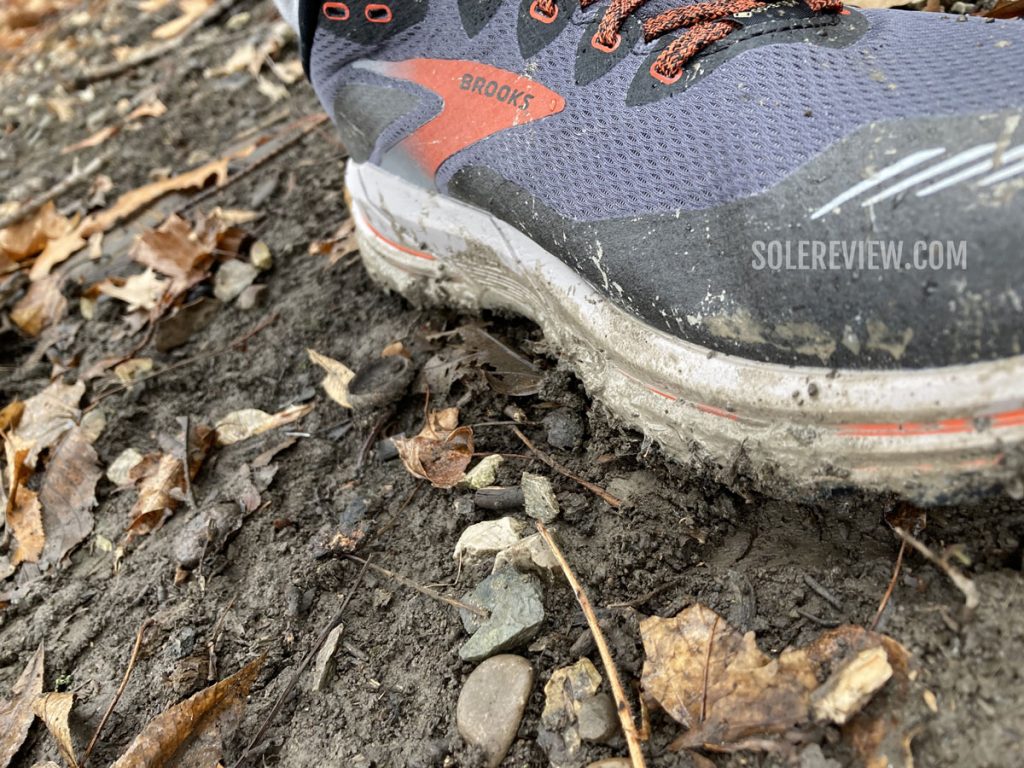
Or does it have to be a highly cushioned shoe for impact protection and high-mileage comfort?
If you’re running on wet or slippery grounds, then it’s important to have the right amount of traction. If this is on a dry path though, there may be too much traction and thus accelerated wear and tear; but if it’s on a muddy surface, it may not have enough grip depending on how deep the mud is.
Nailing the upper fit can mean success or failure. Too loose and you might slide off the midsole, but too tight and your toes will be jammed forward into the reinforced toe bumper.
Given the vast diversity of uses for these shoes, the best thing to do is to recommend them based on what they’re designed for. Soft-roaders and Trail Running Shoes designed for versatility will work well for most people.
The right kind of technical trail shoe comes down to how you want it served. So our third group will show off a diverse collection of shoes for all preference types.
While this guide recommends a diverse selection of trail shoes, you may also want to browse our guides on waterproof and reflective running shoes for more information.
Crossover trail running shoes – these are the outdoor interpretation of road shoes.
These are your favorite running shoes turned into cross-trainers so that you can still enjoy the best parts of them – such as a medial post – while being able to use them for different activities.
Nike Pegasus Trail 3 Gore-Tex
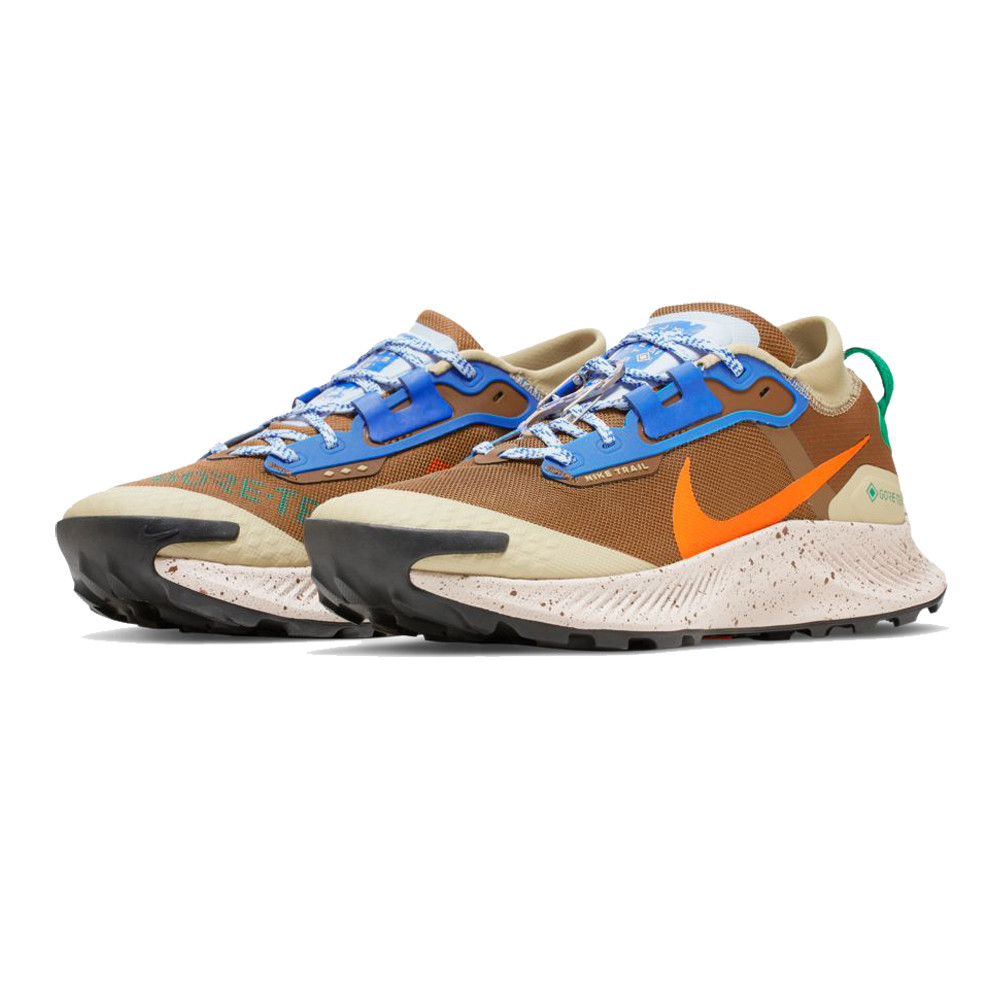
The Pegasus Trail 3 shoes are great for running on low-speed trails through medium difficulty terrain. For a detailed review, click here.
Designed with a soft but supportive React foam midsole, this sneaker delivers hours of comfort while running. The sturdy rubber outsole provides support and stability no matter what type of terrain you encounter.
Though the midsole of this shoe lacks a rock shield (as opposed to the Terra Kiger), it also provides extra cushioning where you need it most – underfoot. Due to its sensitivity, this model is unsuitable for fast speed runs on technical terrain but offers great versatility and comfort for all types of off-road activities.
And just like any Nike running shoe with React foam, the midsole will harden in below-freezing temperatures.
The upper and outsole come together to form the toe-bumper of the shoe, protecting it from potential damage.
We recommend the Gore-Tex variant because it has an exterior which repels water. This way, you do not have to worry about getting your feet wet even if they get spilled on accident.
Though the redesigned Pegasus Trail 4 has been out in the market for some time now, we are still waiting for its performance graphics card version.
New Balance Fresh Foam Hierro V7
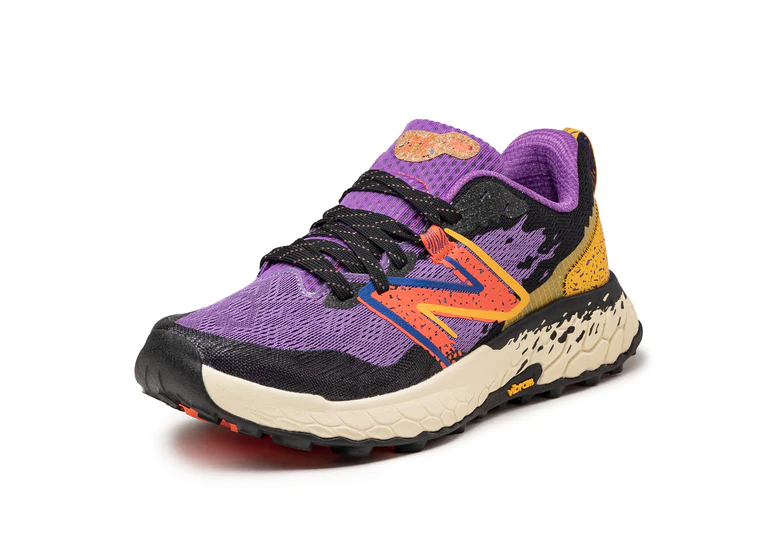
With a Fresh Foam midsole, this shoe offers extra cushioning. Stability is provided by the outsole, which is made of durable Vibram rubber.
The top portion of the shoe is well-protected thanks to the generous amount of printed TPU. Sizing runs smaller and narrower than usual, so it’s best to buy a size up from what you would normally wear.
And just like the Pegasus Trail, we view the Hierro as a trail shoe for flat and mildly technical trails. The flat outsole lug geometry also makes it perfect for running both on pavement or dirt roads.
Versatile trail running shoes.
Use them every day on most terrain- as long as they are not too challenging.
Adidas Terrex Agravic Flow 2
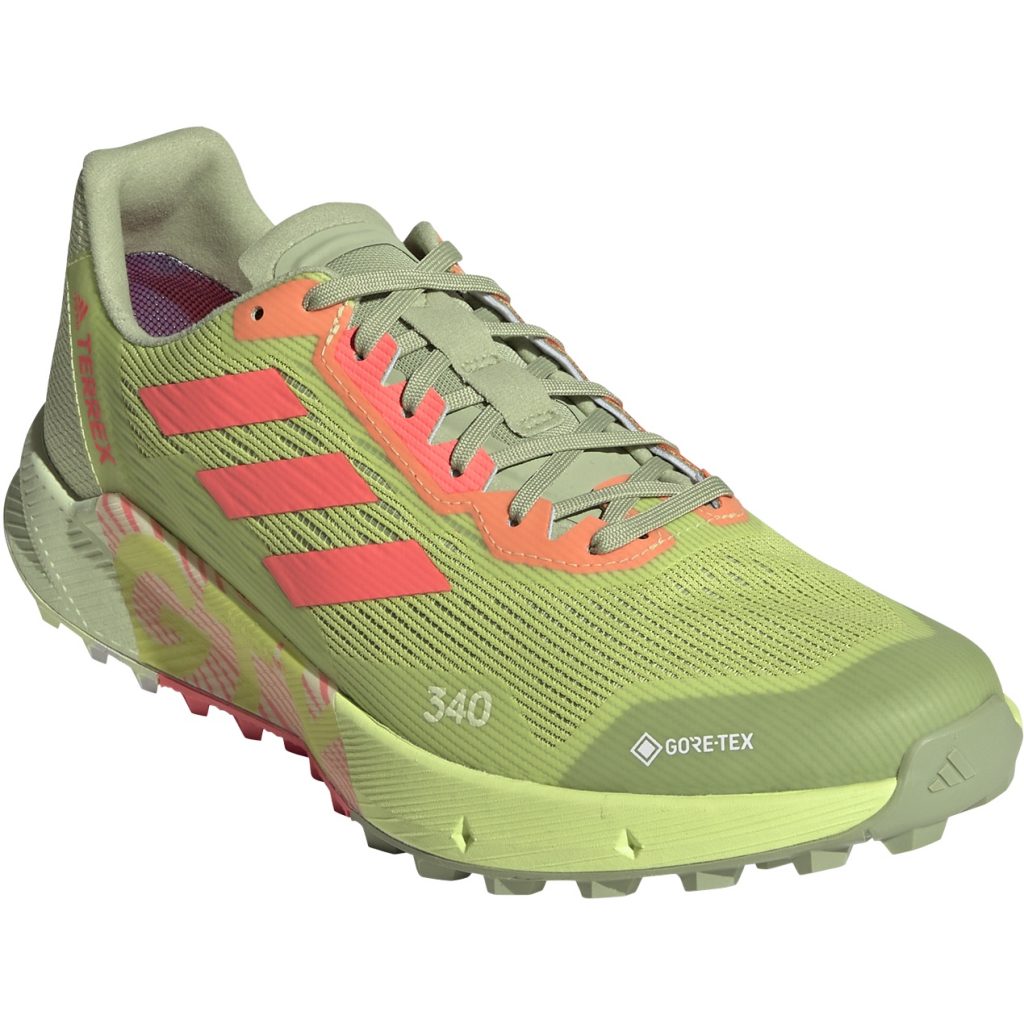
The adidas Terrex Agravic Flow has been completely revamped and there is no trace of its former incarnation.
The previous iteration of this model had a combo midsole made up of Boost and EVA that provides stability throughout. A snug upper allows for lockdown without any room for slippage.
The Agravic Flow 2 no longer has the Boost foam; instead, it features a light-weight EVA foam midsole – just like the one found on some models of the adizero adios and Boston.
The result is a trail running shoe with higher levels of stability. This can be attributed to Adidas reinforcing the sides with an ultra-thin film called ‘Promoderator’.
The sturdy yet comfortable design of the shoe was created for exploring natural landscapes such as mountains and forests. It has a full-length Continental rubber outsole with tall and widely spaced lugs for increased stability on an uneven surface.
Though it doesn’t have a gaiter attachment, the waterproof Gore-Tex material ensures you won’t get wet. And for dry running conditions, the ventilated mesh layer with reinforced support creates a protective yet breathable fit.
Nike Terra Kiger 8
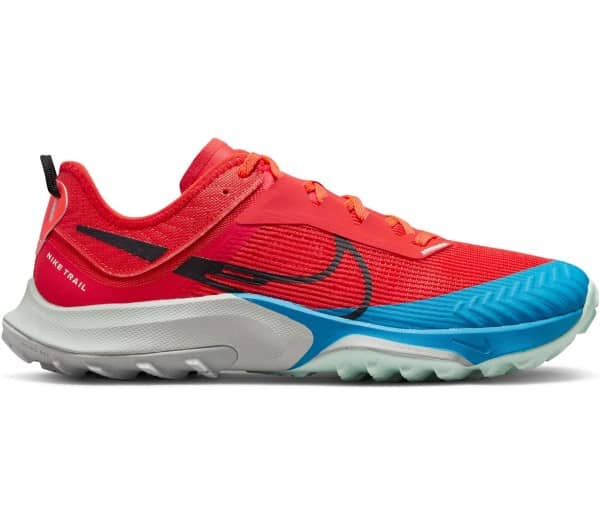
The Terra Kiger 8 offers all the essentials for an avid runner looking for one shoe to meet all of their needs.
There is a protective yet functional layer made of sticky rubber under an outsole to ensure that you always keep your footing in place. The cushioned feeling comes from React foam and Zoom Air technology.
However, the Kiger 8 is not a profoundly plush shoe like the Wildhorse 7 or Pegasus Trail 3.
This shoe has a relatively low profile with only 16.5mm at the heel and 12mm at the toes. It also has a stiff Zoom bag inside which can provide proprioception, making you feel more connected to what’s below your feet.
These Nike Air Zoom Pegasus 34 running shoes provide ventilation for when it gets hot but still provide the needed support and protection for my feet. The upper fits securely around my feet and keeps them locked in place thanks to the simple yet effective laces created with loops.
Each Terra Kiger model’s sole unit is the same, so there is not much difference between them. However, the Kiger 8’s upper is exceptionally breathable due to its enlarged pores.
Given the context, the Kiger 8 will perform poorly on muddy terrain or rainy days. The Pegasus Trail 3 GTX or Cascadia 16 GTX would be better choices for such surface conditions.-
Saucony Peregrine 12

The Peregrine 12 was released in February, which means it has been around for at least 10 years.
With very few shoe brands lasting this long, we can see why the Peregrine is still around. With its new design, the Peregrine 12 has all the basic features of a trail runner down pat.
While the EVA foam midsole was comfortable and stable enough for multiple running styles, it did not lack in cushioning or protection. With additional features such as a forefoot rock shield that protected my feet from potential injuries caused by roots and rocks, this trail runner had me feeling confident – without sacrificing comfortability- while running my way through various types of terrain.
The outsole is made from the sticky PU Powertrax rubber which excels on wet and dry surfaces alike. Obviously, it can’t do so on smooth rock or ice-covered ground.
It’s not without its comforts. Saucony has equipped the V12 with a built-in power run+ (E-TPU) insole for that wonderful feeling of softness when you step into it.
The mesh upper is both comfortable and protective – perfect for those who want a soft yet secure sensation while they’re on the trail. This shoe also has the mesh tongue and padded heel which provides you with an easy grip, while its fused design protects your feet from rocks that may poke out of the ground.
A Soft Terrain model with bungee cord lacing is also available. Both of these models have a metal D-ring for gaiters to attach onto it.
Salomon Sense Ride 4 – wet and dry trails

The Salomon Sense Ride 4 is finally here! While there has been no change in the cushioning or traction, we can’t help but notice how different this year’s model looks.
The Sense Ride 4 now features an upgraded heel collar that has cushioned padding for a better feel. The tongue flap has been redesigned, but it still comes with the love-it-or-hate-it lace garage feature. If you ask us, the next iteration of the shoe should simply do away with those bungee laces and switch to regular old shoelaces instead.
The shoe fit remains good at keeping the foot in place; however, the bungee-style Quicklace is difficult to work with.
The ride comfort is achieved by the Optivibe foam blend which makes it great for long distance runs. This design delivers enough stability and efficiency when running trails.
With its ample lugs, the sense ride 3 provides solid footing when climbing rocky terrain or when racing through puddles of water. Its do-it-all approach to outsole design allows it to work well on both asphalt and dirt roads.
The only downside of this jacket is it’s not water resistant, but for an extra $40, you can get a Gore-Tex variant.
Hoka Challenger ATR 6
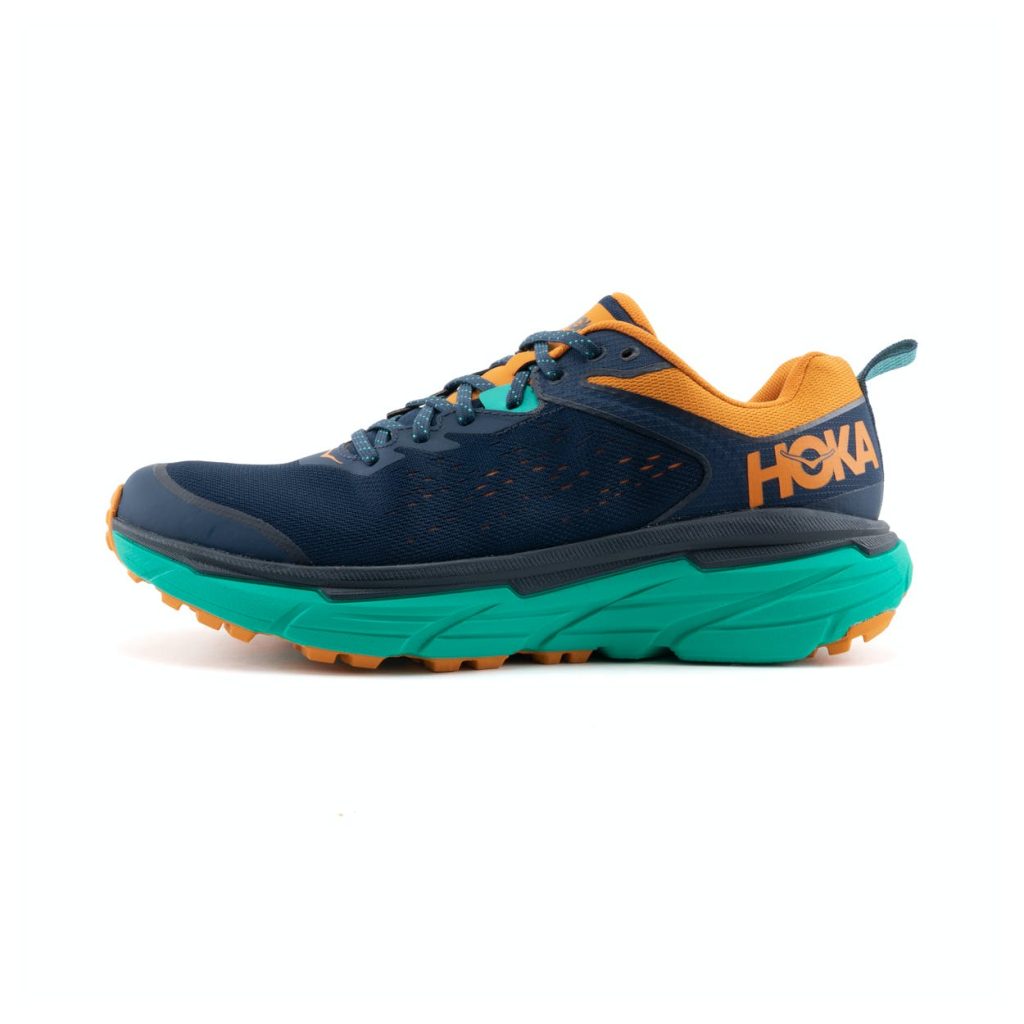
Some trail runners prefer running shoes with extra cushioning that is perfect for long distances.
The Hoka Challenger ATR 6 does not have a rock plate, but it has plenty of midsole cushioning for protection. It also has great stability – perfect for me since I like to go running on rugged trails and through mud puddles! Plus, it still has enough traction so that my feet won’t slip when they come in contact with slippery surfaces.
Hoka uppers continue to improve with each new year and the ATR 6 is no exception. The new design allows for a much more comfortable fit.
Brooks Cascadia 16 GTX – wet and dry
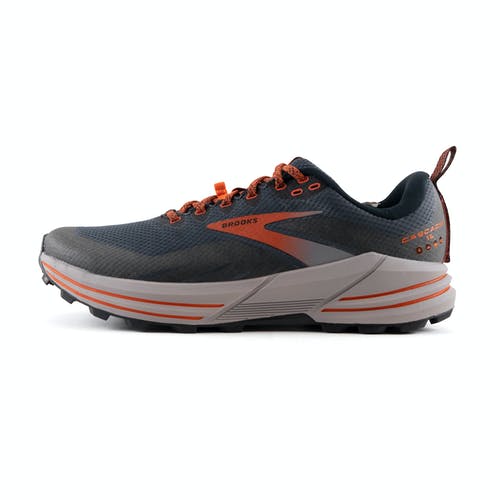
Recently, we took a look at the Cascadia 16 GTX from Salomon. This shoe is perfect for trail running and serves up some serious cushioning along with many features you would find in an everyday off-road runner.
For instance, the midsole has a flexible rock plate which is protective without interfering with the resiliency of the shoe. It also features a Trailtack rubber outsole that grips most terrains (except for smooth rocks and snow) while its gaiter attachment points allow you to customize it as necessary.
Both the Standard and Gore-Text Cascadia models share the same cushioning system and treads; therefore, they feel identical when worn.
Although it lacks the Pivot Posts featured on older Cascadia models, this single-density EVA foam cushion is extraordinarily comfortable for high mileage trail runs.
Although the Cascadia 16 has a cushioned ride it lacks proprioceptive feedback so it’s not great for speed runs on technical trails. The width of the sole also means you’re loosened up around your foot – making these shoes bad for fast paced running.
Other than that, the upper of this shoe is comfortable and secure on the inside. The waterproof Gore-Tex upper material is sturdier than a normal one due to its laminated construction which does an excellent job at keeping out water.
Altra Lone Peak 6
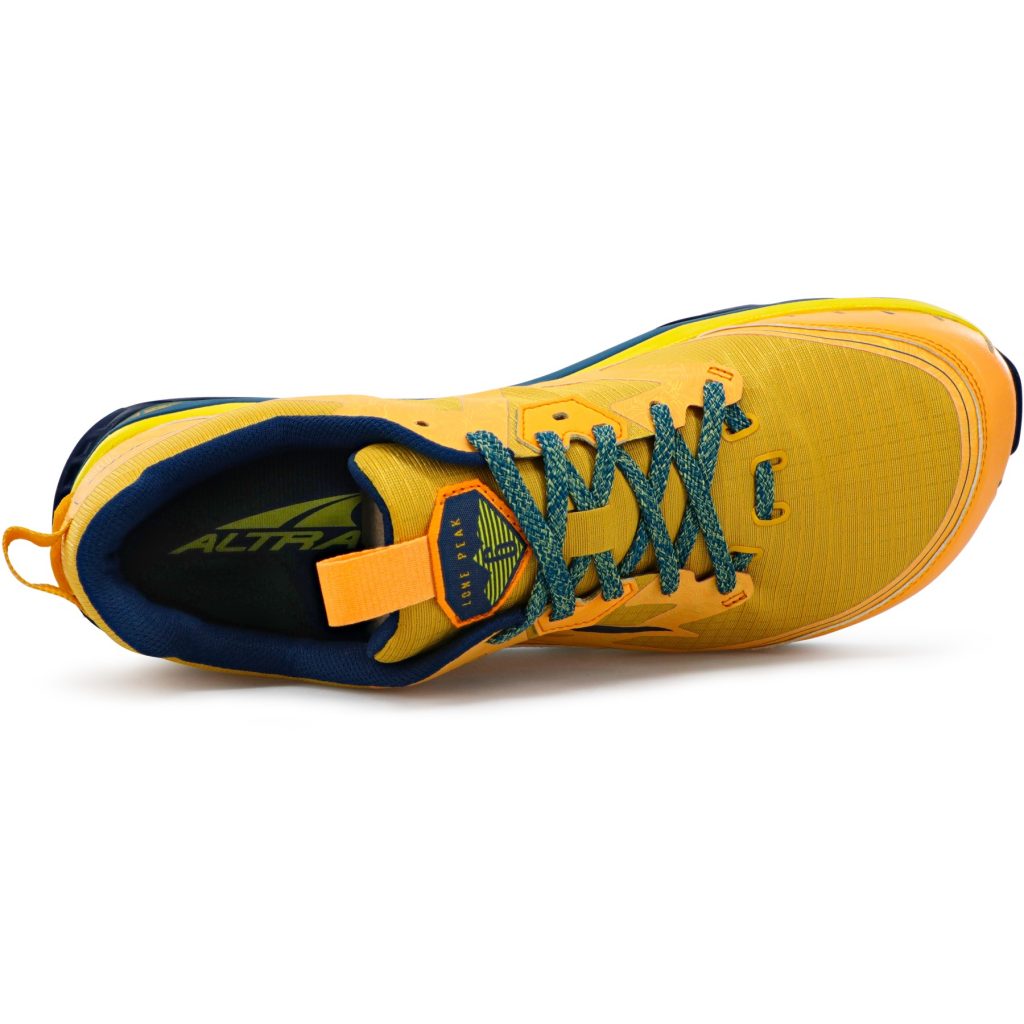
This is the only trail running shoe on this guide with a 0 mm heel-to-toe offset. There’s no difference between the thickness of the midsole whether it be at your foot or your heel.
The zero-drop midsole has been designed to absorb full-contact impacts while giving runners a cushioned layer of protection against the ground.
The Altra Lone Peak 6 is all function over form – it doesn’t have a cool appearance or showy features, but it provides everything a trail runner would need for their feet. The Stoneguard plate offers extra protection from rocks and sticks poking up through the ground, while strong rubber toe lug grips can stick to pretty much anything thanks to its MaxTrac tread pattern.
The lacing system of the boot provides a snug fitting and prevents it from sliding off during activities. In the event of a need for a gaiter attachment, it can be attached to prevent anything from getting inside. The protective ripstop mesh keeps any debris away while still allowing moisture to escape when necessary, helping to prevent blisters or sore spots on your feet.
This is the only running shoe in this article with a 0mm heel-to-toe offset – no matter where you land on the ground, there is always an equal amount of cushioning.
Technical trail running.
Reserve these shoes for the roughest terrain and slopes. Due to their water-resistance, they are capable of handling slippery conditions
Salomon Speedcross 5
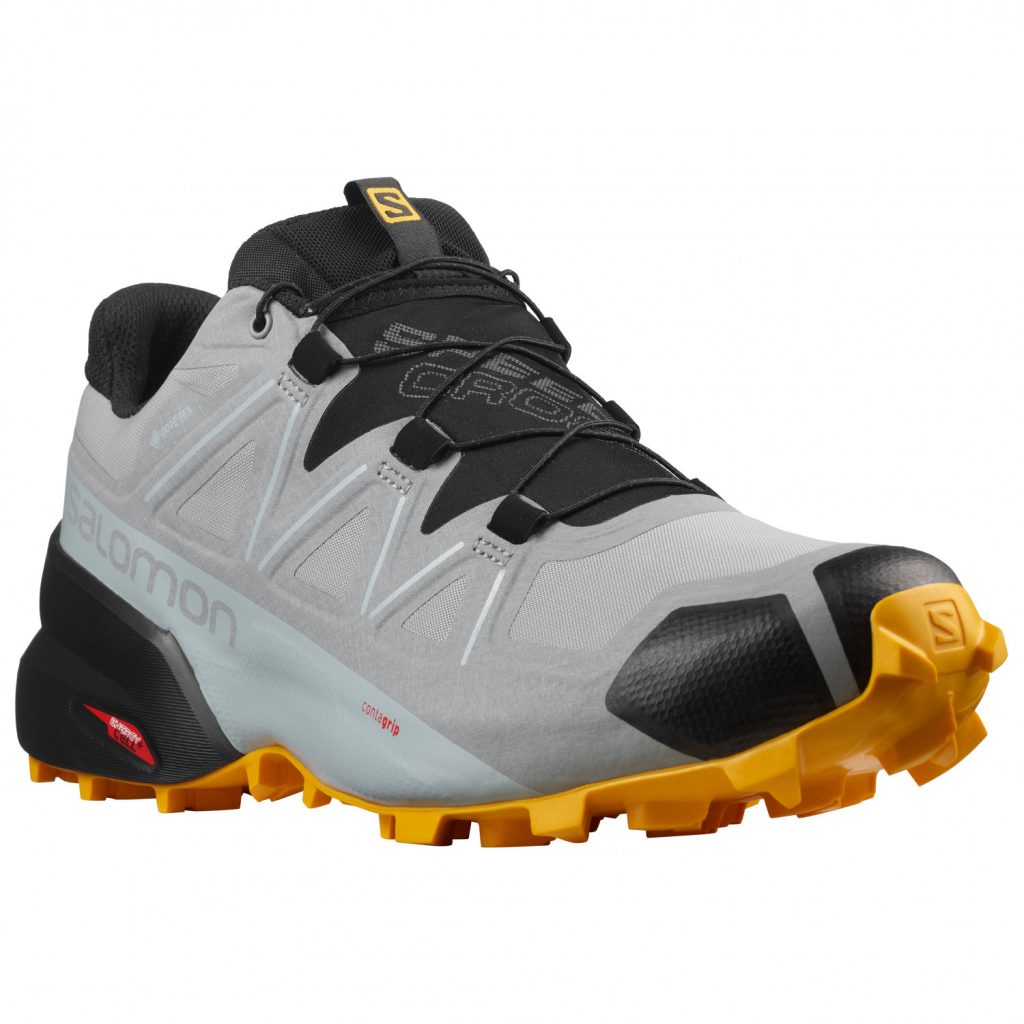
If getting dirty or soaked on the trail is something you enjoy while running, then it’s hard to go wrong with Salomon Speedcross 5.
These long and wide-spaced lugs will cling tightly without getting clogged. The heels and forefeet are equipped with lugging surfaces facing in different directions, making them appropriate for use on rugged terrains going up or down hills.
The slim outsole also plays a part in helping me stand firmly. The narrow width pressures the lugs, producing a firmer grip on challenging terrain. This capability is due to its double-lasted construction; which means it can last longer before wearing down or tearing up.
This construction of an upper covering the midsole and folding over the outsole has many beneficial effects including making a slim outsole which not only looks nice but also provides stability for those difficult terrains.
The Speedcross upper is perfect for those who want the features of a running shoe but don’t want to give up style. A functional design, this pair has fused layers that offer dust free protection while still remaining breathable with a closed mesh. The bungee laces are easy to tighten, though it would be nice if there were some lace pockets for storage like on the S-Lab Ultras or Sense Ride 3s
Designed for long-distance runners, the Ortholite insole and internal midsole provide a comfortable cushioning system that stabilizes feet during running.
Hoka Speedgoat 5 – wet and dry

This shoe model is equipped with a standard Vibram Megagrip outsole which provides reliable traction when traversing over wet and slippery surfaces. For added safety, the 5mm lugs dig deep into the ground for solidity and assurance on slick terrain, making this one of the best shoes available today.
The firmness of the midsole provides me with stability while riding my bike over uneven terrain and protects me from roots and rocks.
The new and improved Speedgoat 5’s upper is made from knitted material which is comfortable on my feet.
Speed trail running shoe: adidas Terrex Speed Ultra Trail

Coming to think of it, there aren’t many quick and light shoes made for running in off-road trails.
Indeed, the adidas Terrex Speed Ultra proved to be an exception. It’s speedy and sturdy on uneven terrain without compromising its cushioning comfort or integrity. The rear midsoles have resilient boost foam cores for added stability, with the remaining midsoles supported by a firmer Lightstrike EVA frame for balanced longevity.
Having a firm EVA under the forefoot not only provides protection but also allows for stability and good ground feedback.
This is where the Speed part of Terrex Speed Ultra comes in handy. With the firm midsole working closely with the grippy Continental rubber outsole for efficient transitions, and snug upper keeps you strapped down over any trail type, there isn’t any waterproofing which would have been nice to have.



